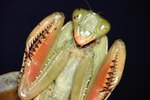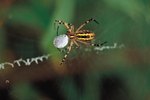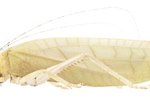
Wasps are omnivores: They will switch between hunting prey and eating nectar, tree sap and fruit, depending on availability. Wasps select prey based on size. If a wasp senses that it has the strength to overpower an insect or grub, the wasp will give it a go. A small handful of wasp species are large enough to take down, kill and eat a grasshopper.
Grasshopper Predator Species
European hornets (Vespa crabro L) grow to approximately 25 millimeters in length as adults. These predatory insects, imported from Europe and discovered in the United States around 1840, are notorious for their predation of insects, with the grasshopper among their most favored prey items. Red wasps (Polistes humilis), bicolored hornets (vespa bicolor), lesser banded hornets (vespa affinis), vespa velutina -- medium-size hornets, the larger vespa soror hornets and even paper wasps (Parapolybia indica) will eat grasshoppers if available.
Hunting Method
Although wasps are equipped with powerful stingers, those aren’t their only tools in the predatory process. In fact, some of the larger species, such as bicolor hornets, don’t need to sting at all. First, the wasps restrict their grasshopper prey from moving. They do this may holding grasshoppers with with their legs. Then they will sting the grasshoppers to paralyze them and prevent them from fighting back. Once they have a good grip on their prey, the wasps will start to eat, regardless of whether the grasshoppers are dead or alive. Smaller wasp species, such as the European hornets, will hunt in groups; others, like vespa soror and bicolored hornets, are ambush predators. They hang out in places they know grasshoppers live, then strike swiftly.
Grasshopper Defense
The grasshopper is no match for a wasp. His only hope of survival is to spot the wasp before the predator can get hold of him and make a swift getaway. He will do this using his powerful back legs to project him into a lengthy hop . A grasshopper can jump the human equivalent of half a football field. Some grasshopper species have defensive secretions that serve to dissuade predators from hunting more grasshoppers. The secretions are a passive evolutionary defense -- they won't save a grasshopper from fatal injury, but they'll make a predator think twice before biting another. The red wasp has been observed to be unaffected by these secretions.
Also on the Menu
Wasps also eat caterpillars, flies, bees, ants, spiders and even other wasps. The wasps' choice of prey is determined by their habitat. Insects of a size small enough to be easily devoured are typically fair game for the wasp. Whether or not he successfully makes said insect his prey depends on availability of the insect and whether the insect is capable of defending itself or escaping.
References
Photo Credits
-
John Foxx/Stockbyte/Getty Images
Writer Bio
Simon Foden has been a freelance writer and editor since 1999. He began his writing career after graduating with a Bachelors of Arts degree in music from Salford University. He has contributed to and written for various magazines including "K9 Magazine" and "Pet Friendly Magazine." He has also written for Dogmagazine.net.




